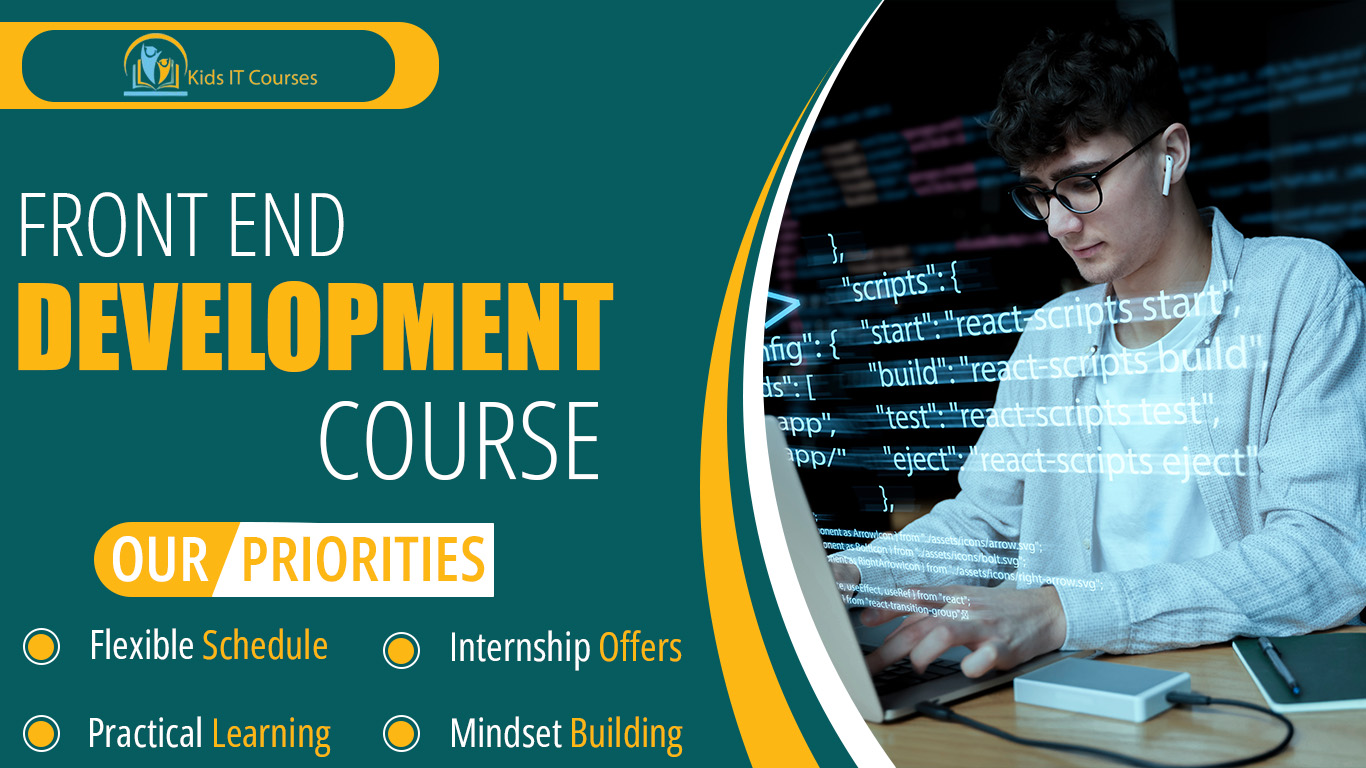
Front-End Development Course for Kids
- In this super-cool course, kids learn how to build websites that look awesome and work smoothly.
- They get to use code like a digital superpower—turning designs into real, clickable websites.
Definition
• Kids learn how to design the parts of a website people see. It’s like decorating a digital room with colors, buttons, and pictures!
• They use HTML to add content, CSS to style it, and JavaScript to add action. These are the basic building blocks of a webpage.
• They plan layouts, fix mistakes, and try fun ideas. It improves both brainpower and imagination.
• Kids learn how to make things happen when you click or scroll. This brings the website to life!
• They use beginner-friendly tools just like real web designers. This gives them practical, hands-on experience.
• They build personal websites, blogs, or online posters. Seeing their work online gives them confidence and joy.
Importance
• Kids learn how to design buttons, images, text, and layouts. They create the part of the website people see and use.
• They choose colors, fonts, and styles to match their ideas. It helps them express themselves through design.
• They learn how to arrange website parts in smart ways. This improves their thinking and planning.
• Kids use the same tools that real developers use. This gives them useful tech experience early on.
• They create their own web pages, games, or online stories. Making and sharing something is super exciting for kids!
• Websites are everywhere—schools, shops, and games. Learning front-end skills opens doors to creative careers.
Advantages for Freelancing Purpose
• Kids learn how to create the parts of a website people see and use. It’s like painting and decorating a digital space!
• They choose colors, fonts, buttons, and layouts. It helps them express their ideas in fun ways.
• Kids use real coding tools to build webpages. They learn the building blocks of the internet.
• They plan where things go and how they work. It teaches clear thinking and smart decision-making.
• When they write code, they can instantly see what changes. This keeps learning fun, visual, and exciting!
• Kids create personal websites, portfolios, and mini games. They feel proud sharing what they build.
More About It
This involves crafting layouts that adapt to different screen sizes and devices (a practice known as responsive design) and ensuring accessibility for users with disabilities by adhering to standards like the Web Content Accessibility Guidelines (WCAG).
- Modern front-end development often involves using sophisticated tools and workflows to streamline the development process.
- Version control systems like Git, task runners like Gulp or Grunt, and package managers like npm or Yarn are essential for managing code efficiently.
- Additionally, front-end frameworks and libraries such as Bootstrap for styling or React for building user interfaces allow developers to create complex applications more quickly and with greater consistency.
- Performance optimization is another crucial aspect of front-end development.
- Developers must ensure that websites load quickly and run smoothly, which involves techniques like minimizing file sizes, optimizing images, and reducing the number of HTTP requests.
In essence, front-end development is the bridge between design and technology, requiring a balance of technical skills, creativity, and user-centric thinking to create websites and applications that are both beautiful and highly functional.
Session 1 : Introduction to Web Development
What is front-end development?
How websites work (basic internet + browser concepts)
Overview of HTML, CSS, and JavaScript
Tools needed: Code editor, browser, and GitHub
Session 2 : HTML Basics
HTML tags and structure
Creating headings, paragraphs, and lists
Adding images, links, and tables
Build a simple “About Me” web page
Session 3 : CSS Styling
What is CSS and how it works
Colors, fonts, backgrounds
Box model and spacing (margin, padding)
Styling the “About Me” page
Session 4 : Layouts with CSS
Intro to Flexbox and Grid (kid-friendly approach)
Creating responsive layouts
Design a mini web portfolio layout
Session 5 : Introduction to JavaScript
What is JavaScript?
Variables, data types, and basic functions
Add interactivity: Button click, change text/color
Build a fun interactive quiz
Session 6 : Bringing It All Together
Combine HTML, CSS, and JS in one project
Build a personal website or digital portfolio
Upload project to GitHub or present to class
✅ Bonus Topics (Optional):
Intro to animations with CSS
Adding Google Fonts and icons
Website design tips for beginners
Exploring websites like CodePen and Replit
